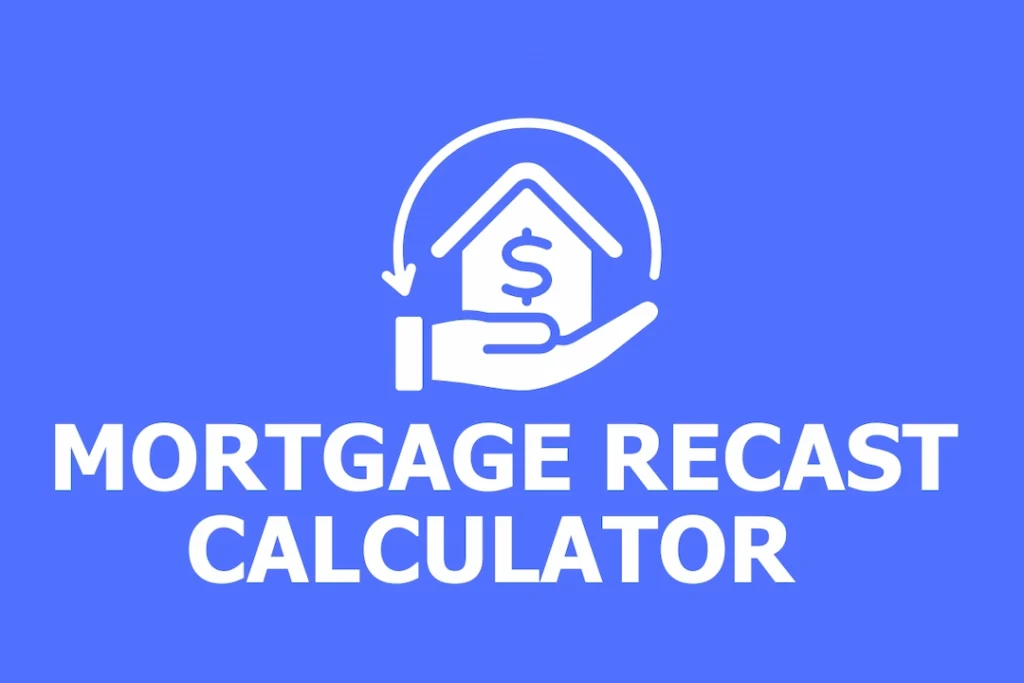When it comes to managing your home loan, understanding how a mortgage recast calculator works can be a real game changer. A mortgage recast allows homeowners to lower their monthly mortgage payments without going through the lengthy and expensive process of refinancing. In simple terms, a mortgage recast calculator helps you see how much you can save by applying a lump sum toward your principal balance.

Content
What Is a Mortgage Recast?
A mortgage recast (also known as a loan recast) is when your lender recalculates your monthly payments based on your remaining loan balance after you’ve made a large lump sum payment. Unlike a refinance, your interest rate and loan term remain the same — only your monthly payment changes.
For example, if you have a $300,000 mortgage and pay off $50,000 toward the principal, a recasting home loan process recalculates your new payments based on a $250,000 balance. The mortgage recast calculator then shows how much lower your monthly payments will be over the remaining loan period.
How Does a Mortgage Recast Calculator Work?
A mortgage recast calculator is a simple yet powerful tool. It factors in your:

- Current mortgage balance
- Interest rate
- Remaining term
- Lump sum payment
After inputting these values, the calculator displays your new monthly payment and how much you’ll save in interest over time. Essentially, it allows you to calculate mortgage recast savings instantly and see if the option fits your financial goals.
Most online mortgage recast calculators are free and easy to use. Many homeowners use them before contacting their lenders to understand potential benefits.
Mortgage Recast vs Refinance: What’s the Difference?
While both options help reduce monthly payments, the difference between a mortgage recast vs refinance lies in cost and complexity.
- Refinancing replaces your current loan with a new one, often requiring new paperwork, credit checks, and closing costs.
- Recasting, on the other hand, keeps your current mortgage in place — you just pay a lump sum toward the principal and your payments are recalculated.
If your goal is to lower monthly payments without changing the loan term or rate, mortgage recasting is often more straightforward and cost-effective.
When Should You Consider a Mortgage Recast?
A mortgage recast can be a smart move if:
- You’ve recently received a large lump sum (e.g., bonus, inheritance, or property sale).
- You want to reduce monthly payments without extending your loan term.
- You prefer to avoid the costs of refinancing.
- Your lender allows recasting (not all do).
For homeowners focused on principal reduction strategies, recasting provides a great middle ground — it saves on interest and reduces monthly obligations while keeping the same interest rate.
Real-Life Case Study: How One Family Used Mortgage Recasting to Their Advantage
Let’s look at a real-world example.
The Johnson Family, based in Colorado, purchased their home for $450,000 in 2018 with a 30-year mortgage at 4.5% interest. After five years, their mortgage balance was about $375,000. When Mr. Johnson received a $75,000 inheritance, they explored their options — refinancing or recasting.
After using a mortgage recast calculator, they discovered that by applying the $75,000 toward their loan principal, their new balance would drop to $300,000. The calculator showed that their monthly payment would decrease from $2,280 to around $1,820 — a savings of roughly $460 per month.
The best part? They didn’t need to pay for appraisal, credit checks, or closing costs typically associated with refinancing. Over time, this mortgage recast saved them more than $20,000 in interest and allowed them to redirect funds toward college savings and home renovations.
This case highlights how using a mortgage recast calculator empowers homeowners to make informed financial decisions that align with long-term goals.
How to Request a Mortgage Recast from Your Lender
Not every lender offers recasting, but most major ones do. Here’s how to get started:

- Contact your lender to confirm eligibility.
- Make a lump sum payment (often at least $5,000–$10,000).
- Submit a recast request — this may involve a small fee (usually $150–$300).
- Receive a recalculated amortization schedule showing your new monthly payments.
Many borrowers use a step-by-step mortgage recast example online or consult with their financial advisor before finalizing the decision.
If your lender doesn’t provide a calculator, you can use a mortgage amortization calculator as an alternative to estimate savings.
Is Mortgage Recasting Worth It?
Whether mortgage recasting is worth it depends on your financial situation. If you have access to a substantial lump sum payment and plan to stay in your home for several years, the savings can be significant. It’s especially appealing for those with low interest rates who want to lower payments without resetting their loan term.
However, if you’re looking to shorten your loan or access home equity, refinancing might be the better option. That’s why using a compare refinance vs recast calculator before making any decision can provide valuable insight.
Final Thoughts
A mortgage recast calculator is a simple yet powerful financial planning tool. It helps you visualize potential savings, understand how lump sum payments affect your loan, and make smart decisions about your mortgage.
As a real estate expert, I’ve seen how this strategy can provide peace of mind for homeowners — especially those who want to stay put and build long-term equity without the hassle of refinancing.
If you’re aiming to lower your monthly mortgage payments, explore how a mortgage recast calculator works and consult your lender. The benefits might surprise you — just as they did for the Johnsons.
FAQs
Can I use a mortgage recast calculator for any type of loan?
Most lenders allow recasting only on conventional loans, so check if your loan type qualifies.
How often can I recast my mortgage?
You can typically recast only once unless your lender offers flexible terms. Always confirm with them.
Does mortgage recasting affect my credit score?
No, a mortgage recast doesn’t impact your credit since it’s not a new loan or refinance.
Is there a minimum amount required for a mortgage recast?
Yes, most lenders need at least a $5,000–$10,000 lump sum payment to qualify for recasting.
Can I use an online mortgage recast calculator before contacting my lender?
Absolutely! It’s the best way to estimate your savings before starting the recast process.

With a sharp eye for design and a passion for renovation, Samantha transforms fixer-uppers into dream homes. Her expertise in remodeling adds extra value to your real estate experience.




